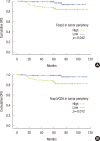Zonal difference and prognostic significance of foxp3 regulatory T cell infiltration in breast cancer
- PMID: 24744792
- PMCID: PMC3988347
- DOI: 10.4048/jbc.2014.17.1.8
Zonal difference and prognostic significance of foxp3 regulatory T cell infiltration in breast cancer
Abstract
Purpose: Forkhead box P3 (Foxp3) is known as the most specific marker for regulatory T lymphocytes, which play an important role in immune tolerance to disturb antitumor immunity. The present study aimed to investigate the prognostic significance of Foxp3 regulatory T lymphocyte (Foxp3 Treg) infiltration in breast cancer.
Methods: Immunohistochemical studies with Foxp3, CD4, and CD8 were performed on representative full tissue sections from 143 patients with invasive ductal carcinoma, not otherwise specified. Foxp3 Treg infiltration and the ratios between Foxp3 Treg and CD4 or CD8 T cells were separately analyzed for the tumor bed and tumor periphery to evaluate their association with different clinicopathological parameters and patients' outcome.
Results: The tumor periphery was considerably more densely infiltrated by Foxp3 Treg, CD4, and CD8 T cells than the tumor bed. Unfavorable clinicopathological parameters (a Ki-67 labeling index of ≥14%, a worse histologic grade, a worse nuclear grade, hormone receptor negativity, human epidermal growth factor receptor 2 positivity, and tumor recurrence) were associated with increased Foxp3 Treg infiltration and a high ratio between Foxp3 Treg and CD4/CD8 T cells. In the tumor periphery, as Foxp3 Treg infiltration and the Foxp3 Treg/CD8 ratio increased, patients' 5-year disease-free survival rate decreased.
Conclusion: The infiltration densities of Foxp3 Treg, CD4, and CD8 T cells were markedly different between the tumor bed and periphery. Besides the absolute count of Foxp3 Treg, the ratio between Foxp3 Treg and effector T cells was a significant prognostic factor in breast cancer.
Keywords: Breast neoplasms; Foxp3 protein; Humans; Regulatory; T-lymphocyte.
Conflict of interest statement
The authors declare that they have no competing interests.
Figures


References
-
- DiPaolo RJ, Glass DD, Bijwaard KE, Shevach EM. CD4+CD25+ T cells prevent the development of organ-specific autoimmune disease by inhibiting the differentiation of autoreactive effector T cells. J Immunol. 2005;175:7135–7142. - PubMed
-
- Sakaguchi S. Naturally arising Foxp3-expressing CD25+CD4+ regulatory T cells in immunological tolerance to self and non-self. Nat Immunol. 2005;6:345–352. - PubMed
-
- Hori S, Nomura T, Sakaguchi S. Control of regulatory T cell development by the transcription factor Foxp3. Science. 2003;299:1057–1061. - PubMed
-
- Fontenot JD, Gavin MA, Rudensky AY. Foxp3 programs the development and function of CD4+CD25+ regulatory T cells. Nat Immunol. 2003;4:330–336. - PubMed
LinkOut - more resources
Full Text Sources
Other Literature Sources
Research Materials

